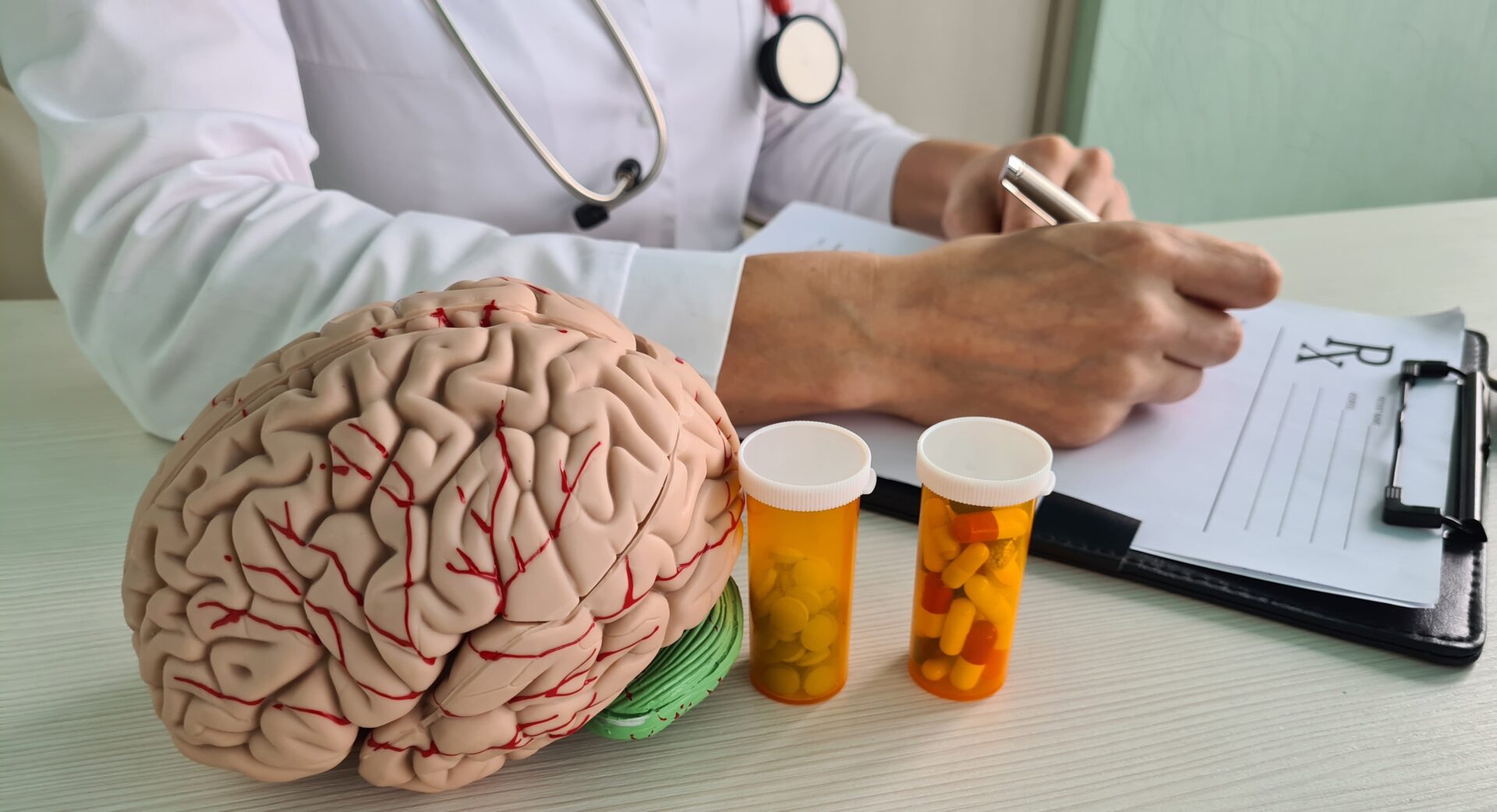Psychiatric drugs are medications specifically designed to treat mental health conditions by affecting brain chemistry and function. Insights about the types of psychiatric drugs available and their potential applications can help people make informed decisions about treatment options. When prescribed appropriately and monitored carefully, these medications can be effective components of comprehensive mental health care plans.

Types of Psychiatric Drugs
Psychiatric medications play a vital role in treating various mental health conditions, helping millions manage symptoms and improve quality of life. While the use of psychiatric drugs in mental health treatment is highly effective in general, these substances are typically most successful when used as part of a comprehensive treatment approach. This may include psychotherapy, lifestyle modifications, social support systems, and more.
Some of the most common types of psychiatric drugs include [1]:
- Antipsychotics: Primarily used to manage psychosis, including hallucinations, delusions, and disordered thinking, antipsychotics work by blocking dopamine receptors in the brain. They’re commonly used to treat schizophrenia, schizoaffective disorder, and psychotic symptoms in bipolar disorder.
- Antidepressants: These medications help alleviate symptoms of depression and are often prescribed for anxiety disorders as well. They typically work by affecting neurotransmitters like serotonin, norepinephrine, and dopamine to help regulate mood, emotion, and cognitive function.
- Anti-anxiety Medications: Also known as anxiolytics, these medications help reduce symptoms of anxiety, such as excessive worry, panic, and fear. They work by enhancing the effects of certain neurotransmitters that promote relaxation and reduce stress responses.
- Mood Stabilizers: Designed to control extreme emotional fluctuations, mood stabilizers are primarily used to treat bipolar disorder and related conditions. They work by balancing certain brain chemicals to prevent manic and depressive episodes.
- Stimulants: Commonly prescribed for attention-deficit/hyperactivity disorder (ADHD), stimulants increase activity in various parts of the brain. They help improve concentration, reduce impulsivity, and manage hyperactivity by affecting neurotransmitters like dopamine and norepinephrine.
How Do Psychiatric Drugs Work?
Psychiatric drugs are psychoactive substances that cross the blood-brain barrier and alter brain functioning. This leads to noticeable changes in both the body and mind, affecting everything from mood to one’s perception of reality [2].
These drugs are often understood through two primary models: the disease-centered model and the drug-centered model. The disease-centered model suggests that psychiatric drugs work by correcting underlying biological abnormalities or imbalances that are thought to cause mental distress. In contrast, the drug-centered model suggests that these medications create altered mental and physical states that help people cope with their symptoms, rather than directly addressing a specific biological cause. While the disease-centered model emphasizes correcting biological imbalances, the drug-centered model illustrates the importance of the altered states these medications create [2].
Given these two opposing views, a personalized approach to mental health treatment is paramount. By considering both models, patients and mental health professionals can make informed decisions about treatment options.
Antidepressant Uses and Types
Antidepressants are primarily designed to alleviate symptoms of depression, though they are also commonly prescribed for other mental health conditions. While they don’t cure depression, antidepressants alter the balance of certain neurotransmitters (specifically serotonin, norepinephrine, and dopamine) that affect mood and emotions. This potentially reduces symptoms and improves quality of life [3].
Antidepressants are approved by the Food and Drug Administration (FDA) for the treatment of various conditions, including [3]:
- Bipolar depression
- Bulimia
- Depressive disorders
- Generalized anxiety disorder
- Obsessive-compulsive disorder (OCD)
- Panic disorder
- Post-traumatic stress disorder (PTSD)
- Social anxiety disorder
Common types of antidepressants and examples of their generic and brand names include [3]:
- Monoamine Oxidase Inhibitors (MAOIs): phenelzine (Nardil), tranylcypromine (Parnate)
- N-methyl-D-aspartate (NMDA) Antagonists: esketamine (Spravato)
- Selective Serotonin Reuptake Inhibitors (SSRIs): citalopram (Celexa), escitalopram (Lexapro), fluoxetine (Prozac), paroxetine (Paxil), sertraline (Zoloft)
- Serotonin and Norepinephrine Reuptake Inhibitors (SNRIs): desvenlafaxine (Pristiq), duloxetine (Cymbalta), venlafaxine (Effexor XR)
- Tricyclic Antidepressants (TCAs): amitriptyline (Elavil), nortriptyline (Pamelor), imipramine (Tofranil)
While antidepressants are essential for managing depression and other mental health conditions, no single medication works for everyone. Thus, it’s important to collaborate with a healthcare provider to explore different types of medications and dosages. This ongoing collaboration can ensure patient safety and effective care.
Anti-Anxiety Medications
Anti-anxiety medications, also known as anxiolytics, reduce symptoms of anxiety disorders and help people manage excessive worry, fear, and panic. They’re typically used to treat generalized anxiety disorder, panic disorder, specific phobias, and PTSD [4]. Unlike antidepressants, which are a fairly well-defined class of substances, anti-anxiety medications come in many different forms, ranging from antihistamines and benzodiazepines to beta-blockers and sedative-hypnotics.
Given the various types of anxiolytics, anti-anxiety effects are produced in several different ways. Some anti-anxiety meds, like benzodiazepines and barbiturates, increase cell activity by promoting the release of gamma-aminobutyric acid (GABA), a neurotransmitter that calms the nervous system. Others, such as beta-blockers, slow down the sympathetic nervous system, which is responsible for the “fight-or-flight” response. Meanwhile, antidepressants prevent the reabsorption of neurotransmitters like serotonin and norepinephrine, making more of these mood-regulating chemicals available in the brain [4].
Interestingly, some medications can have multiple effects. For example, buspirone and hydroxyzine can both increase activity in certain cells while decreasing it in others, offering a balanced approach to managing anxiety [4].
With so many options available, it’s essential for patients to work closely with their healthcare providers to find the right medication and dosage. Ultimately, the choice of anti-anxiety medication depends on potential side effects and associated risks of dependence or withdrawal symptoms as well as one’s specific anxiety condition and personal health factors.
Stimulant Uses and Types
Stimulants increase activity in the central nervous system, enhancing focus, attention, and alertness while reducing hyperactivity and impulsivity. They are often prescribed for attention-deficit/hyperactivity disorder (ADHD), binge-eating disorders, and narcolepsy. Stimulants primarily work by increasing the availability of certain neurotransmitters, particularly dopamine and norepinephrine, in the brain. By enhancing these neurotransmitters, stimulants help improve communication between brain cells involved in attention, behavior control, and executive function [1].
Common types of stimulants used in mental health treatment include amphetamine-based stimulants such as amphetamine/dextroamphetamine (Adderall) and lisdexamfetamine (Vyvanse). They also include methylphenidate-based stimulants such as methylphenidate (Ritalin, Concerta, Daytrana) and dexmethylphenidate (Focalin) [5].
While stimulants offer both benefits and risks, research suggests that appropriate therapeutic use of stimulants does not increase the risk of substance use disorders. In fact, proper treatment of ADHD with stimulants may actually reduce the risk of subsequent substance misuse by improving decision-making abilities and reducing impulsive behaviors [5].
Mood Stabilizers
Mood stabilizers are medications that are designed to treat and prevent episodes of mania, hypomania, and depression, particularly in bipolar disorder. They work by calming overactive brain circuits and regulating neurotransmitter activity to help prevent extreme mood swings. While their exact mechanisms vary depending on the specific medication, most mood stabilizers affect ion channels, neurotransmitter systems, or signal transduction pathways in the brain [6].
One of the main types of mood-stabilizing drugs is anticonvulsants. While anticonvulsant indications, or the conditions for which this type of drug is prescribed, include epilepsy and seizures, several variations are regularly used as mood stabilizers. Lithium is also commonly prescribed as a mood stabilizer, though it is not an anticonvulsant.
Common mood-stabilizing agents include [6]:
- Carbamazepine: An anticonvulsant, carbamazepine (Tegretol) stabilizes mood by reducing the excitability of neurons and influencing mood-regulating pathways.
- Divalproex: Also known as valproic acid, divalproex (Depakote) increases gamma-aminobutyric acid (GABA) levels in the brain. This anticonvulsant reduces the excitability of neurons and stabilizes mood, particularly during manic episodes.
- Lamotrigine: Lamotrigine (Lamictal) is an anticonvulsant that works by blocking voltage-sensitive sodium channels to stabilize mood. It’s often used to prevent depressive episodes in bipolar disorder.
- Lithium: Lithium (Lithobid and Eskalith) works by inhibiting inositol uptake, which affects neurotransmitter signaling and helps calm the nervous system.
As with many psychiatric drugs, effectiveness varies according to a host of factors. Thus, the choice of mood stabilizer should be guided by each person’s unique needs and responses to treatment.
Antipsychotic Classifications and Uses
Used primarily to manage psychotic symptoms such as hallucinations, delusions, and disordered thinking, antipsychotic medications block dopamine receptors in the brain. Psychotic symptoms are often associated with conditions such as bipolar disorder, severe depression, and schizophrenia. However, antipsychotic medications can also be prescribed to relieve symptoms of dementia and delirium in older adults [1].
Antipsychotics are generally classified into two main categories, namely first generation (i.e. conventional antipsychotics) and second generation (i.e. atypical antipsychotics). First generation substances include chlorpromazine (Thorazine), thioridazine (Mellari), and fluphenazine (Prolixin). Meanwhile, second generation drugs include clozapine (Clozaril, Fazaclo, Versacloz), risperidone (Risperdal), and olanzapine (Zyprexa) [7].
Conventional antipsychotics are effective at treating symptoms of schizophrenia (e.g., hallucinations, delusions) but often cause significant movement-related side effects. Second-generation antipsychotics generally treat a broader range of symptoms and have a lower risk of movement disorders [1]. However, they may cause metabolic side effects such as weight gain and an increased risk of diabetes [7].
Side Effects of Psychiatric Drugs
While psychiatric medications can be life-changing and even lifesaving, they commonly cause side effects that vary in severity. The specific effects depend on medication class, personal factors, dosage, and treatment duration. As such, professional monitoring of psychiatric drugs is essential to manage adverse effects and ensure that the benefits outweigh the risks for each person.
Common side effects by medication type include:
- Anti-Anxiety Medications (variable by substance): drowsiness, slowed reactions, confusion [4]
- Antidepressants: drowsiness, headache, upset stomach, diarrhea, sexual dysfunction [3]
- Antipsychotics: sedation, dizziness, weight gain, dry mouth
- Conventional antipsychotics: tardive dyskinesia
- Second generation antipsychotics: metabolic issues [7]
- Mood Stabilizers (variable by substance): tremors, hypothyroidism, weight gain, GI disturbances, itching, rash, headaches, dizziness, blurry vision, lethargy [6]
- Stimulants: decreased appetite, irritability, edginess, sleep problems, dry mouth [5]
Side effect severity varies between individuals. However, many symptoms diminish over time as the body adjusts to medication.
The Role of Medication in Mental Health
Psychiatric medications represent a valuable tool in the management of mental health conditions, offering not only relief but also improved functioning for millions of people worldwide. However, medications are rarely the complete solution to complex mental health challenges.
Rather, the most effective approaches typically involve a combination of appropriate medications with psychotherapy, lifestyle modifications, social support, and other evidence-based interventions. This comprehensive approach tackles the biological, psychological, and social dimensions of mental health.
However, for these strategies to be truly effective, we must also address the societal perceptions that can hinder progress. As society continues to confront mental health treatment stigma, it’s vital to promote understanding and acceptance of these life-changing medications and mental health treatment as a whole.
- National Institute of Mental Health. (2023, December). Mental health medications. National Institute of Mental Health. https://www.nimh.nih.gov/health/topics/mental-health-medications. Accessed 30 April 2025.
- Guy, A., Davies J., Rizq, R. (Eds.) (2019). Guidance for psychological therapists: Enabling conversations with clients taking or withdrawing from prescribed psychiatric drugs. London: APPG for Prescribed Drug Dependence. https://prescribeddrug.info/guidance-for-psychological-therapists/. Accessed 30 April 2025.
- Cleveland Clinic. (2023, March 1). Antidepressants. Cleveland Clinic. https://my.clevelandclinic.org/health/treatments/9301-antidepressants-depression-medication. Accessed 30 April 2025.
- Cleveland Clinic. (2023, March 1). Anxiolytics. Cleveland Clinic. https://my.clevelandclinic.org/health/treatments/24776-anxiolytics. Accessed 30 April 2025.
- Stevens, J. R., Wilens, T. E., & Stern, T. A. (2013). Using stimulants for attention-deficit/hyperactivity disorder: clinical approaches and challenges. The primary care companion for CNS disorders, 15(2), PCC.12f01472. https://doi.org/10.4088/PCC.12f01472. Accessed 30 April 2025.
- Nath M, Gupta V. (2023, April 24). Mood Stabilizers. In: StatPearls [Internet]. Treasure Island (FL): StatPearls Publishing; 2025 Jan-. https://www.ncbi.nlm.nih.gov/books/NBK556141/. Accessed 30 April 2025.
- Tamminga, C. (2025, March). Antipsychotic drugs. Merck Manual Professional Version. https://www.merckmanuals.com/professional/psychiatric-disorders/schizophrenia-and-related-disorders/antipsychotic-drugs. Accessed 30 April 2025.
Our Clinical Affairs Team is a dedicated group of medical professionals with diverse and extensive clinical experience who actively contribute to the development of our content, products, and services. They meticulously evaluate and review all medical content before publication to ensure it is medically accurate and aligned with current discussions and research developments in mental health. Please visit our Editorial Policy for more information.
MentalHealth.com is a health technology company guiding people towards self-understanding and connection. The platform provides reliable resources, accessible services, and nurturing communities. Its purpose is to educate, support, and empower people in their pursuit of well-being.
Linda Armstrong is an award-winning writer and editor with over 20 years of experience across print and digital media.
Dr. Shivani Kharod, PhD, is a medical reviewer with over 10 years of experience ensuring health content is accurate and accessible.
Our Clinical Affairs Team is a dedicated group of medical professionals with diverse and extensive clinical experience who actively contribute to the development of our content, products, and services. They meticulously evaluate and review all medical content before publication to ensure it is medically accurate and aligned with current discussions and research developments in mental health. Please visit our Editorial Policy for more information.
MentalHealth.com is a health technology company guiding people towards self-understanding and connection. The platform provides reliable resources, accessible services, and nurturing communities. Its purpose is to educate, support, and empower people in their pursuit of well-being.


